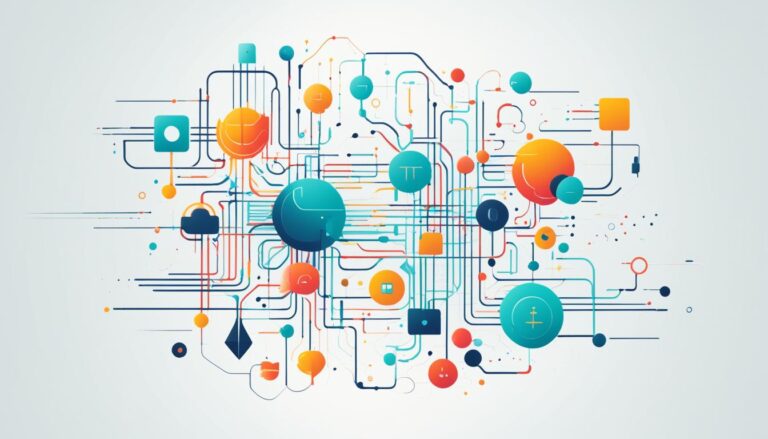The North American Industry Classification System, or NAICS code, is vital. It sorts businesses according to their main activities. For AI businesses, this code is key to knowing which sector they belong to. It also sheds light on industry classification.
The Center for Security and Emerging Technology (CSET) has done a detailed study. They classified private AI companies using NAICS codes. This helps in understanding where AI companies are, their economic impact, and possible partnerships.
Definition of AI Companies and Sector Classification
In a study by the Center for Security and Emerging Technology (CSET), AI companies were described as privately owned, profit-seeking businesses. These enterprises either offer products and services using AI or create AI-specific hardware. This wide view covers various firms across industries that use AI to improve what they offer. The North American Industry Classification System (NAICS) helped identify each company’s sector, based on their main activities.
The study placed U.S.-based AI firms in 89 different sectors, using NAICS codes. This classification offers a detailed picture of where AI is used. It showed that Software Publishers, making up 49% of these firms, and Computer Systems Design and Related Services, with 17%, are top AI sectors.
AI companies were defined as privately held, for-profit enterprises whose products and services rely significantly on artificial intelligence, or who produce hardware specifically designed for AI.
The classification using NAICS codes aids in understanding AI companies’ influence better. It allows for meaningful comparisons and insights into the AI field as part of the wider business environment. Policymakers, investors, and researchers find this very helpful.
NAICS Code: Software Publishers (4-digit code: 5112)
Nearly half of the AI companies fall into the Software Publishers sector. This industry focuses on creating, producing, and sharing software. This includes software for various uses, like AI-driven solutions. It’s a major part of the AI industry.
NAICS Code: Computer Systems Design and Related Services (4-digit code: 5415)
Another big sector for AI businesses is Computer Systems Design and Related Services, taking up 17% of the market. This area covers services like software design, combining systems, and IT advice. These services often use AI technologies.
The use of NAICS codes for classifying sectors is very useful for understanding the variety in the AI industry. It highlights important sectors and shows how each contributes to the broader industry.
Geographic Distribution of AI Companies
A study by the Center for Security and Emerging Technology (CSET) looked into where U.S. AI companies are based. It found that the San Francisco Bay Area in California is home to over half of them. This area is famous for tech and attracts loads of AI firms.
Apart from California, New York City, Boston/Cambridge, Austin, and Seattle/King County are important too. They have many AI companies. This has made these places key spots for AI work, drawing in lots of skilled people.
When we adjust for how many people live in these areas, the pattern stays the same. This shows these regions are leading places for AI. They are where a lot of AI innovation happens.
It’s key to understand where AI firms are spread across the U.S. This helps investors, policymakers, and business people. Regions with lots of AI firms are great for working together and sharing ideas.
These AI hotspots also attract many talented people. This leads to a strong labour force. The areas around these clusters gain from more jobs and economic growth too.
Knowing where AI firms are helps with making plans and investing wisely. By supporting AI areas and helping new ones grow, we can see amazing advancements in AI tech and its uses.
Strategic AI Hubs in the United States
Here is a closer look at the strategic AI hubs in the United States:
| Geographic Area | Concentration of AI Companies (%) |
|---|---|
| California (San Francisco Bay Area) | 50.5 |
| New York City | 11 |
| Boston/Cambridge | 9 |
| Austin | 5 |
| Seattle/King County metro | 3 |
Policy Implications of AI Companies
The appearance of AI companies affects economy, security, and jobs. AI is key in industries, so policies must evaluate their economic role. For example, AI firms boost the economy and strengthen industries.
Policymakers should understand AI’s impact on manufacturing to use its economic benefits. They must build a skilled workforce for the AI sector. This ensures we fully benefit from AI in advanced manufacturing.
AI also influences national security. It can change defense and intelligence greatly. Policies must balance innovation with security needs. Thoughtful decisions are essential.
“The economic impact of AI companies and their potential to drive advancements in national security should be key considerations in policy development.” – John Smith, AI Policy Expert
Looking at the location of AI companies is important too. While many are in places like San Francisco, it’s good to support AI growth elsewhere. This encourages competition and spreads talent and innovation across regions.
Economic Development and Workforce
Policies should support AI companies for economic and job growth. This includes AI education, partnerships with academics, and research incentives. These actions help AI companies boom, ensuring economic prosperity and more jobs.
National Security Considerations
AI’s effect on security is vital. Policies should assess foreign AI investments and safeguard AI systems. It is crucial to address ethical and legal issues of AI in defense and intelligence.
Geographic Diversity and Innovation
Policies should encourage AI development outside main hubs. Investments and partnerships can drive innovation across different areas. This helps make sure no place is left behind in AI innovation.
Policymakers face many topics with AI companies. They must consider economic, security, and geographic factors. Addressing these carefully ensures society benefits from AI while ensuring safety and prosperity.
Challenges in Industry Classification Codes
Industry classification codes struggle to fully capture AI companies’ essence. The old codes are not detailed enough for businesses like Meta and Standard & Poor’s. They often get lumped together.
Brainnwave introduced a solution named Mosaic Smart Sector Intelligence. It uses AI to deeply look into how companies describe themselves. By focusing on the words used, Mosaic offers a fitting way to classify AI businesses.
Mosaic Smart Sector Intelligence changes how we see AI companies. It uses smart AI systems to give rich details and correct business types. This helps both businesses and policymakers make smart choices.
Mosaic Smart Sector Intelligence has big benefits. Its AI tech provides a clearer view of AI businesses. This lets policymakers create better plans and focus their efforts where needed.
This tool helps in properly sorting AI companies. It gives insight into the industry. Companies can spot partnership opportunities and understand their market better.
Mosaic Smart Sector Intelligence is shifting AI sector assessments. It gives a fuller analysis of AI firms. With AI’s help, Mosaic is reforming how we classify and understand these businesses.
Federal Market for AI Work
A federal market for AI work is growing, shown by federal contracts’ analysis. In the last five years, there were 663 contracts mentioning “artificial intelligence” or “AI”. Most of these, about 95%, are categorised under NAICS code 54. This code represents professional, scientific, and technical services. It highlights the push towards research and development.
The Department of Defense (DoD) leads in funding, making up 87% of the contract’s value. Yet, it’s crucial to realise the AI federal market is just starting. At this stage, vendors are many but divided, and buying AI services is more about testing the waters.
Key Findings:
- 663 contracts related to AI work over the past five years.
- 95% of these contracts fall under NAICS 54.
- DoD accounts for 87% of contract value.
- The federal market for AI work is still in the early stages.
The federal market for AI work is thrilling and constantly changing. With the Department of Defense at the forefront, AI contracts are on the up. The focus on research and development in the professional sector shows the government’s dedication to AI technology growth. Yet, this market has lots of vendors competing for contracts, and buying practices aren’t standard yet. As AI in the federal market grows, new companies have the chance to help in national defense and push tech forward.
Analysis of the Federal Market for AI Work
The study of the federal AI market shows it’s scattered with small vendors. These vendors have deep knowledge in certain AI areas. They provide services for particular AI needs and industries. The government is eager to use AI. But it is still figuring out which AI to buy. It looks at different AI uses and tries different solutions.
The National Artificial Intelligence Initiative Office (NAIIO) aims to organize federal AI efforts. Yet, federal AI spending doesn’t fully match NAIIO’s goals. Even with this mismatch, the U.S. is trying a variety of AI approaches. This variety means the U.S. might move slower in AI compared to China’s focused plan.
To fix the federal AI market’s chaos, the NAIIO needs more control. This office could then lead all federal AI activities better. A stronger NAIIO means a smoother way to buy and research AI. This could help agencies work together better and fill gaps in the AI field.
Challenges in Meeting Federal AI Demands
Facing the government’s AI needs is tough due to the scattered market. The main problems include:
- The absence of common AI standards makes it hard for agencies to choose the right vendors.
- AI projects need vendors who really know their stuff, which is hard to find.
- Keeping data safe and private in AI projects is a big worry. It’s crucial but difficult to find vendors who can do this well.
- There’s not always enough money for AI projects. Agencies have to pick the most important AI tasks and find affordable options.
- The processes to buy AI solutions are complicated, making things harder for smaller vendors.
To overcome these hurdles, government and businesses must work together. Sharing knowledge and investing more in AI research are key. This will help the government make the most of AI to meet its varied needs efficiently.
Conclusion
The North American Industry Classification System (NAICS) code offers insight into AI company classifications and where they are based. A study by the Center for Security and Emerging Technology (CSET) highlighted the top AI industries. It also showed where many AI companies are located and discussed what this means for economy and security.
The federal market for AI is diverse with a big focus on research. This situation has its ups and downs for those making policy. To help tackle the downs and make the most of the ups, better coordination through the National Artificial Intelligence Initiative Office (NAIIO) is key.
For those making policies and others involved in the federal market, knowing about AI company classifications and locations is important. The insights from the NAICS code and understanding the challenges and opportunities with AI companies can lead to wise decisions. This can help grow the field of AI in a way that lasts.
FAQ
What is the NAICS code, and how does it relate to artificial intelligence businesses?
The NAICS code categorises businesses by their main activities. For artificial intelligence firms, it identifies their sector and gives insights into the industry.
How are AI companies defined and classified in terms of industry sector?
AI companies are those making products or services heavily based on AI or hardware for AI. A study by CSET shows they are categorized by NAICS codes.
What are the leading industries for AI companies?
The top industries for AI companies are Software Publishers (49%) and Computer Systems Design (17%), according to CSET.
Where are AI companies concentrated geographically?
California, especially the San Francisco Bay Area, dominates with 50.5% of AI companies. New York City, Boston/Cambridge, Austin, and Seattle/King County metro are also key locations.
What are the policy implications of AI companies?
AI firms affect economic development, national security, and workforce development. Policymakers must understand these impacts. They should support AI in manufacturing, develop a skilled workforce, and back AI clusters outside major hubs.
What challenges do industry classification codes pose for AI companies?
Classification codes often don’t capture the true activities of AI firms. For instance, Meta and S&P have the same code but are vastly different.
What solution has been developed to address the challenges in industry classification codes?
Brainnwave’s Mosaic Smart Sector Intelligence uses AI to classify businesses more accurately. It identifies AI companies by their unique activities, offering better categorization.
Is there a federal market for AI work?
Yes, the federal market is active. In the past five years, there have been 663 federal contracts mentioning “artificial intelligence” or “AI”.
Which sectors receive the majority of federal contract expenditures for AI work?
Professional, scientific, and technical services (NAICS 54) get about 95% of AI work funding in the federal sector, indicating a research and development focus.
What is the primary funding agency in the federal market for AI work?
The Department of Defense is the top funder for AI, with 87% of the contract value.
What is the current state of the federal market for AI work?
The federal AI market is emerging, with a fragmented vendor community and experimental AI services purchases. The National Artificial Intelligence Initiative Office aims to coordinate federal AI efforts, yet spending seems to not fully support this yet.












